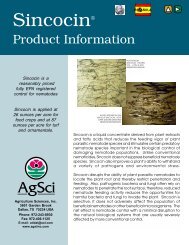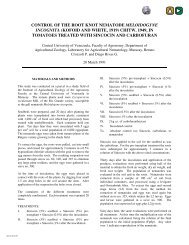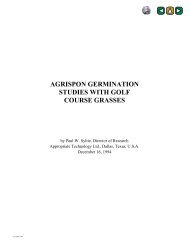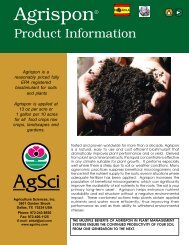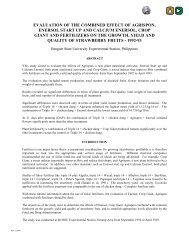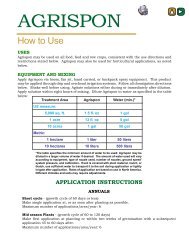R325 - Effect of Different Rate of Azotobacter ... - Agrisciences.com
R325 - Effect of Different Rate of Azotobacter ... - Agrisciences.com
R325 - Effect of Different Rate of Azotobacter ... - Agrisciences.com
Create successful ePaper yourself
Turn your PDF publications into a flip-book with our unique Google optimized e-Paper software.
If a cytokinin is applied directly to the lateral yolk, inhibited by the active tip <strong>of</strong> the stem, the growth <strong>of</strong> the lateral<br />
bud is stimulated. It is possible that cytokinins originate in the roots and rise in the organic solutes <strong>of</strong> the xylem, by<br />
their presence it is deduced that there is a firm correlation between root growth and the upper portion parts <strong>of</strong> the<br />
plants. An over abundance <strong>of</strong> roots causes the slow down in their growth, since this causes a reduction in the<br />
concentration <strong>of</strong> the cytokinins in the organic solutes (WEIER, E. and STOCKING, R. 1980).<br />
Foliar absorption is based on the process <strong>of</strong> diffusion <strong>of</strong> liquids through a semi-permeable membrane and is<br />
selective in the sense that dissolved elements move to a less concentrated solution from a higher concentration,<br />
(JUÁREZ, G. 1956).<br />
It is believed that the entrance into the plant <strong>of</strong> nutrients applied to the foliage is through the discontinuities <strong>of</strong> the<br />
epidermal. In the parallel layers <strong>of</strong> the epidermal cells <strong>of</strong> the leaves <strong>of</strong> many plants, there are pectin like substances<br />
embedded in the cutinizadas area; these pectin like substances extend vertically starting from the surface going<br />
toward the interior <strong>of</strong> the leaf constituting a continuous passage to the walls <strong>of</strong> the vascular extensions and directly<br />
toward the vascular system <strong>of</strong> the leaf, and roots (CROCOMO, O and OTHERS, 1965).<br />
Works exist that prove that the effectiveness <strong>of</strong> foliar absorption is closely related to the structure <strong>of</strong> the leaf,<br />
species <strong>of</strong> the plant, leaves <strong>of</strong> the same plant and several parts <strong>of</strong> the same leaf can have an effect (ZIRENA, D.<br />
1977).<br />
In an experiment on onion production using Agrispon and <strong>Azotobacter</strong>, it was shown: That the treatment with<br />
<strong>Azotobacter</strong> had a yield <strong>of</strong> 8,383 kg/ha, Agrispon 7,177 kg/ha and the control 8,115 kg/ha. In spite <strong>of</strong> this neither<br />
the <strong>Azotobacter</strong> nor Agrispon showed statistical significance. Concluding that it is more advisable to use<br />
<strong>Azotobacter</strong> spp. before Agrispon application, to obtain the best yields and also to be more economical<br />
(CADENILLAS, A. 1985).<br />
Building soil not only depends on factors that exists in smaller quantity, all <strong>of</strong> the factors need to be increased<br />
proportionally when increasing any one factors until arriving at a maximum production; arriving at this maximum, a<br />
new increase <strong>of</strong> a single factor without increasing the other factors causes a decrease in the yield. This is known as<br />
the Law <strong>of</strong> <strong>Effect</strong>iveness <strong>of</strong> the Factors <strong>of</strong> Growth” (SELKE, W. 1968).<br />
Chapter III<br />
MATERIALS AND METHODS<br />
1. Characteristic <strong>of</strong> the Experimental Field.<br />
1.1. Location - This experiment was carried out in the Agricultural Experimental Center “La Victoria", at the<br />
National University <strong>of</strong> Cajamarca, located 2,450 m.s.n.m., latitude 0:07 (11 ' S: longitude 78 O 20' W: with<br />
a dry temperate climate whose climatic characteristics (Averaged 1973-1984) are:<br />
Maximum temperature: 21.4 O C, minimum temperature: 6.4 O C, median temperature: 13.3 O C, total<br />
precipitation: 480.9 mm.<br />
1.2. Climatic conditions during the development <strong>of</strong> the cultivation.<br />
4




